

Middle School Thesis Statement
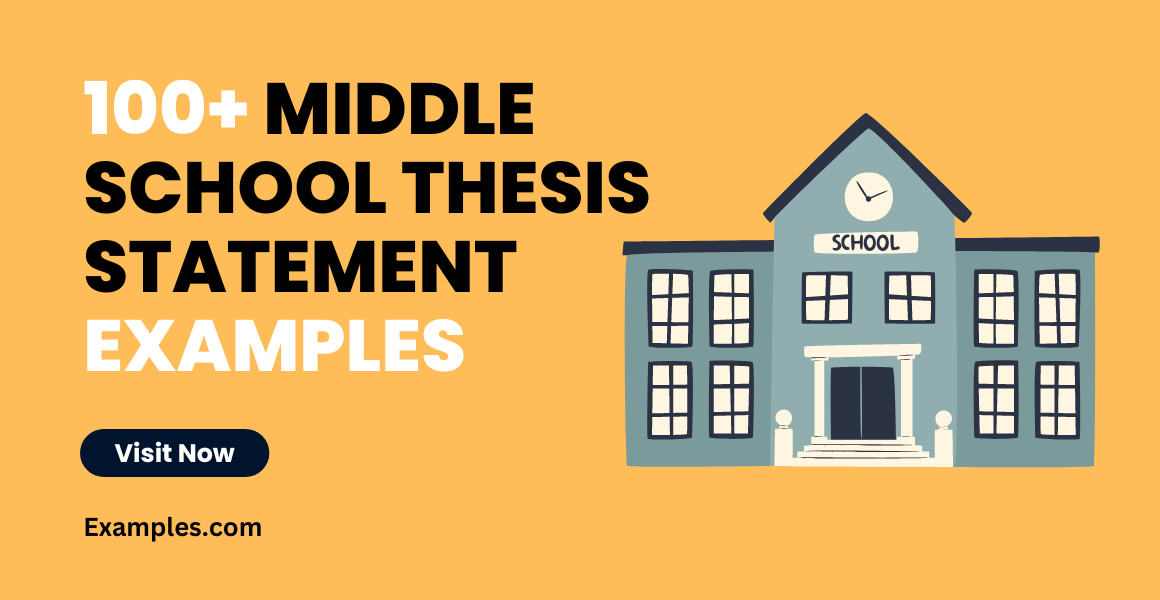
In middle school, students begin to familiarize themselves with the concept of thesis statements , laying the groundwork for more complex writing tasks in the future. Crafting a thesis statement at this level is crucial for developing strong writing skills and analytical thinking. This guide provides middle schoolers with essential examples, a step-by-step approach to writing, and helpful tips to ensure they create compelling and clear thesis statements to elevate their essays and reports.
What is a thesis statement for middle schoolers? – Definition
A thesis statement for middle schoolers is a concise sentence or two that clearly presents the main idea or argument of a piece of writing. It serves as a roadmap for readers, helping them understand what the writer intends to convey or prove. For middle school students, a thesis statement often takes a simpler form than in more advanced academic writing but remains essential for guiding the direction of their essays, reports, or projects.
What is a good thesis statement Example for Middle School?
“Despite its reputation for being an aggressive breed, with proper training and socialization, pit bulls can be loyal and gentle family pets.”
A Good thesis statement provides a clear stance on the topic (the nature of pit bulls) and gives a hint about the supporting points the essay might discuss (training and socialization). It’s straightforward and suitable for the middle school level.
100 Thesis Statement Example for Middle School
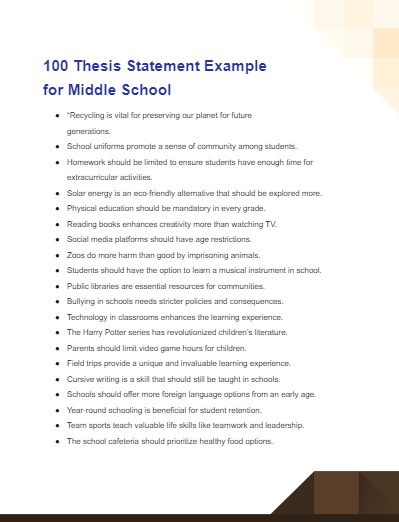
Size: 148 KB
Crafting a clear and compelling thesis statement in middle school lays the foundation for advanced essay writing in high school and beyond. These statements are simpler than their high school thesis statement counterparts but serve the crucial role of guiding the direction of an argument or analysis. Here, we provide a selection of examples tailored for the budding middle school writer.
- Recycling is vital for preserving our planet for future generations.
- School uniforms promote a sense of community among students.
- Homework should be limited to ensure students have enough time for extracurricular activities.
- Solar energy is an eco-friendly alternative that should be explored more.
- Physical education should be mandatory in every grade.
- Reading books enhances creativity more than watching TV.
- Social media platforms should have age restrictions.
- Zoos do more harm than good by imprisoning animals.
- Students should have the option to learn a musical instrument in school.
- Public libraries are essential resources for communities.
- Bullying in schools needs stricter policies and consequences.
- Technology in classrooms enhances the learning experience.
- The Harry Potter series has revolutionized children’s literature.
- Parents should limit video game hours for children.
- Field trips provide a unique and invaluable learning experience.
- Cursive writing is a skill that should still be taught in schools.
- Schools should offer more foreign language options from an early age.
- Year-round schooling is beneficial for student retention.
- Team sports teach valuable life skills like teamwork and leadership.
- The school cafeteria should prioritize healthy food options.
- Art and music classes are as essential as science and math.
- Volunteering should be encouraged in middle school.
- Outdoor learning can be a valuable addition to traditional classrooms.
- History lessons should cover diverse cultures and perspectives.
- Summer vacations are essential for students’ mental well-being.
- Pets in school can aid in stress reduction and emotional learning.
- Teachers should integrate more modern literature into the curriculum.
- Learning a second language benefits cognitive development.
- Excessive testing can put undue stress on students.
- Schools should have programs that teach financial literacy.
- Mobile phones in schools are more distracting than beneficial.
- Gardening programs teach students about sustainability and biology.
- Early bedtimes benefit students’ concentration and health.
- Schools should incorporate more hands-on experiments in science classes.
- The study of mythology offers insights into various cultures.
- Students should learn about global current events in addition to history.
- Virtual reality can revolutionize classroom learning.
- Longer recess breaks benefit students’ concentration.
- Online learning platforms are vital tools for modern education.
- Schools should encourage students to read newspapers.
- Space exploration should be a part of the school curriculum.
- Schools should host annual events celebrating cultural diversity.
- Students should be educated about internet safety.
- Math can be made fun through interactive learning tools.
- Public speaking lessons can boost students’ confidence.
- Schools should teach students about healthy eating habits.
- Parents and teachers need to collaborate for students’ success.
- Peer mentoring can help students adjust to middle school.
- Schools should have counselors to address students’ mental health.
- Writing in journals can improve students’ writing skills.
- Students should be taught the importance of voting from an early age.
- Environmental education is crucial for a sustainable future.
- Ancient civilizations offer valuable lessons for the modern world.
- Students benefit from learning through documentaries and films.
- Creative writing boosts imagination and communication skills.
- Schools should emphasize the importance of critical thinking.
- Robotics clubs can foster interest in science and technology.
- The education system should prioritize experiential learning.
- Schools should have programs that promote kindness and empathy.
- Learning about world religions fosters tolerance and understanding.
- Digital literacy is as important as traditional literacy.
- Daily reading time in schools can enhance vocabulary and comprehension.
- Parent-teacher meetings should be held regularly.
- Schools should reduce the emphasis on grades.
- Education on climate change is essential for younger generations.
- Schools should offer classes on basic life skills.
- Celebrating achievements, big or small, boosts students’ morale.
- Schools should have workshops on time management.
- Middle schoolers benefit from learning about careers and professions.
- Setting personal goals can drive academic success.
- Debates in school foster analytical and critical thinking.
- Learning about entrepreneurship encourages innovation.
- Schools should prioritize classes on ethics and morality.
- Students should be exposed to various forms of art.
- Science clubs can inspire future scientists and researchers.
- Middle schoolers should be educated on digital privacy.
- Learning through games makes education more engaging.
- Schools should encourage independent research projects.
- Students benefit from understanding different political systems.
- Physical activity breaks can enhance classroom focus.
- Schools should have a broader range of extracurricular activities.
- Peer feedback sessions can improve writing skills.
- Astronomy should be introduced to middle schoolers.
- Community service projects instill a sense of responsibility.
- Middle schools should offer classes on logic and reasoning.
- Real-world math problems make learning more applicable.
- Schools should provide resources for learning beyond textbooks.
- Geography lessons should include current world events.
- Middle schoolers should be educated about online scams and fraud.
- Schools should promote creativity over rote learning.
- Workshops on effective communication benefit students in the long run.
- Learning about local history connects students to their community.
- Schools should educate students on the dangers of drugs and alcohol.
- Teaching negotiation skills can be beneficial in everyday life.
- Outdoor adventure programs can boost teamwork and leadership.
- Schools should foster a love for lifelong learning.
- Middle schoolers benefit from understanding basic economics.
- Drama and theater can enhance students’ expressive skills.
- Schools should have more guest speakers from various professions.
- Learning about nutrition can promote lifelong healthy habits.
Thesis Statement Examples for 6th Grade Students
At this age, students begin to form stronger opinions and arguments. The thesis statements are simple, clear, and easy to support with evidence.
- Dogs make better pets than cats because they are more loyal and trainable.
- Reading books helps improve imagination more than watching TV.
- Video games can teach important life skills if played in moderation.
- Homework should be limited on weekends to encourage outdoor activities.
- Solar energy is better than fossil fuels for preserving the environment.
- Field trips are essential for hands-on learning in schools.
- Eating vegetables is crucial for growing kids as they provide essential nutrients.
- Winter is the best season because it brings holidays and snow sports.
- Recycling should be made compulsory in all schools.
- Swimming is the most beneficial sport for overall health in kids.
Thesis Statement Examples for 7th Grade Students
As students mature, their thesis statements can tackle more complex issues, yet remain concise and debatable.
- Online schooling can be just as effective as traditional schooling when implemented correctly.
- Cursive writing should still be taught in schools despite the rise of technology.
- Social media has more negative effects than positive ones for teenagers.
- Schools should start later in the morning to ensure students get enough sleep.
- Zoos do more harm than good by keeping animals in captivity.
- All students should learn a second language from a young age.
- Students should wear uniforms to promote equality and reduce distractions.
- Fast food consumption leads to severe health problems in young individuals.
- Art and music classes are as important as core subjects in middle school.
- Bullying in schools can have long-term mental effects on victims.
Thesis Statement Examples for 8th Grade Students
At this stage, students delve deeper into societal issues and controversies, offering a nuanced perspective in their statements.
- Climate change is the most pressing issue of our generation and requires immediate action.
- Genetic modification in food can be beneficial if regulated properly.
- Animal testing for cosmetics should be banned worldwide.
- The age for acquiring a driver’s license should be raised to 18.
- Reality TV promotes unhealthy stereotypes and should be viewed with skepticism.
- Technology addiction in teenagers is leading to decreased physical activity.
- Students should be educated about the dangers of tobacco and alcohol from a younger age.
- The internet, though beneficial, has also given rise to increasing cyberbullying cases.
- Schools should actively promote STEM subjects for girls.
- Historical monuments representing controversial figures should be preserved with context.
Middle School Thesis Statement Examples for Persuasive Essay
Persuasive essays aim to convince readers to adopt a particular viewpoint. The persuasive essay thesis statement should be compelling and offer a clear stance.
- Planting trees in urban areas is vital for maintaining air quality and community health.
- Junk food in school cafeterias contributes to childhood obesity and should be replaced.
- Digital textbooks are more efficient and eco-friendly than paper ones.
- Physical education classes should be mandatory throughout middle school.
- Restricting screen time for children encourages better sleep and healthier habits.
- Volunteering should be integrated into the school curriculum for character development.
- Parents should monitor their children’s online activities to ensure safety.
- Students should have more say in designing the school curriculum.
- Reward systems in schools can boost motivation and performance.
- Local communities should invest more in public libraries.
Middle School Thesis Statement Examples for Argumentative Essay
Argumentative essays thesis statement present arguments on both sides. The thesis states a clear position on a contentious issue.
- Animal experimentation is unjustifiable, regardless of its potential benefits to humans.
- Introducing foreign languages in early grades leads to better cognitive development.
- Surveillance cameras in schools infringe on student privacy rights.
- The benefits of space exploration far outweigh the associated costs.
- All middle schools should adopt a vegetarian menu for environmental and health reasons.
- The grading system in schools stifles creativity and individualism.
- Strict parental controls on the internet are a necessity in today’s digital age.
- Public transportation should be free for students to encourage its use.
- Corporal punishment in schools does more harm than good.
- Modern educational technology tools enhance learning more than traditional methods.
Middle School Thesis Statement Examples for Informational Essay
Informational essays present factual information. The thesis sets the stage for the topic to be explored.
- The water cycle is an essential natural process that supports life on Earth.
- Ancient Egyptian pyramids were architectural marvels and had significant cultural importance.
- Photosynthesis is the process through which plants produce their food and release oxygen.
- The Great Wall of China, built over centuries, served as protection and a symbol of power.
- Hurricanes are powerful storms that arise from specific atmospheric conditions.
- The life cycle of a butterfly consists of four stages: egg, larva, pupa, and adult.
- The human skeletal system provides structure and supports bodily movements.
- Mars, often called the “Red Planet,” has intrigued scientists for potential signs of life.
- The Amazon Rainforest, the world’s largest tropical rainforest, hosts unparalleled biodiversity.
- The Internet’s invention has revolutionized communication, information access, and business.
How do you write a thesis statement for middle schoolers? – Step by Step Guide
- Understand the Purpose of a Thesis Statement : Begin by explaining to middle schoolers that a thesis statement expresses the main point of their essay and serves to guide the ideas within it. It tells the reader what to expect.
- Select a Topic : Encourage students to choose a topic they are passionate about or one they’d like to explore. The more interest they have in a topic, the easier it will be to write about.
- Ask a Question About the Topic : After selecting a topic, have them phrase it as a question. For example, if the topic is “recycling,” the question could be, “Why is recycling important for our environment?”
- Answer the Question : The answer to this question can form the basis of the thesis statement. Using the above example, an answer might be: “Recycling is essential for our environment because it reduces waste, conserves resources, and minimizes the impact on landfills.”
- Keep It Specific : Ensure that the thesis is not too vague. A good thesis provides a clear and specific point. Instead of writing, “Books are good,” they might write, “Reading books enhances vocabulary, improves concentration, and encourages empathy.”
- Limit to One or Two Sentences : A thesis should be concise. Middle schoolers should be taught to express their main idea succinctly.
- Avoid Opinion Phrases : Teach them to avoid starting their thesis with phrases like “I think” or “I believe.” The thesis should assert a fact or a stance, not merely present an opinion.
- Revise and Refine : Encourage rewriting the thesis a few times to make it stronger and clearer. As they gather more information for their essay, their thesis might need adjustments.
- Seek Feedback : Have students share their thesis statements with peers or teachers for feedback. Others can provide insight into whether the statement is clear and convincing.
- Practice Makes Perfect : Provide ample opportunities for middle schoolers to practice writing thesis statements on various topics. Over time, the process will become more intuitive.
Tips for Writing a Thesis Statement for Middle School Students
- Start Simple : Especially for younger middle school students, starting with a simple and straightforward topic can make the process less intimidating.
- Use Templates : Offering a template can be beneficial. For instance: “[Topic] is essential because of [Reason 1], [Reason 2], and [Reason 3].”
- Always Back it Up : Remind students that whatever claim they make in their thesis, they should have evidence or reasons to back it up in the essay.
- Stay Flexible : Let students know it’s okay to change their thesis as they delve deeper into a topic. Research might lead them to a different perspective.
- Be Clear and Direct : Encourage students to avoid jargon or overly complex words. Their thesis should be easily understood.
- Avoid Being Too Broad : A common mistake is making a thesis too broad. For instance, instead of saying “Pollution is bad,” they could specify, “Plastic waste harms marine life.”
- Practice Debates : Allow students to practice debating on various topics. This helps them learn to form arguments, which can translate into stronger thesis statements.
- Use Real-World Examples : Relating the thesis statement to current events or real-world issues can make the process more engaging and relevant for students.
- Stay Organized : Teach students the importance of outlining their essays. This can help them see where their thesis fits and how their arguments should be structured.
- Encourage Creativity : While the structure of a thesis has a specific format, students can still be creative in how they present their main ideas.
AI Generator
Text prompt
- Instructive
- Professional
10 Examples of Public speaking
20 Examples of Gas lighting
- Skip to primary navigation
- Skip to main content
- Skip to primary sidebar
Activities to Teach How to Write A Thesis Statement
Research Writing , Secondary Literacy , Writing
If there’s any literacy skill you would want your English Language Arts students to master, it would probably be how to write a thesis statement . If you want to teach your students how to write powerful, eloquent, and exceptionally captivating thesis statements, then you’ll love the activities in this article.
The key to any good essay is a strong thesis statement. A strong thesis statement sets the tone and clarifies the author’s purpose : it tells you the writer’s opinion, along with the level of thought and criticism that has gone into formulating it.
A strong thesis statement also creates an alluring introduction paragraph. This makes each paper in your grading pile a lot more inviting.
How do you teach students to write a thesis statement to make their audience continue reading? This blog post explores six activities to teach how to write a thesis statement.
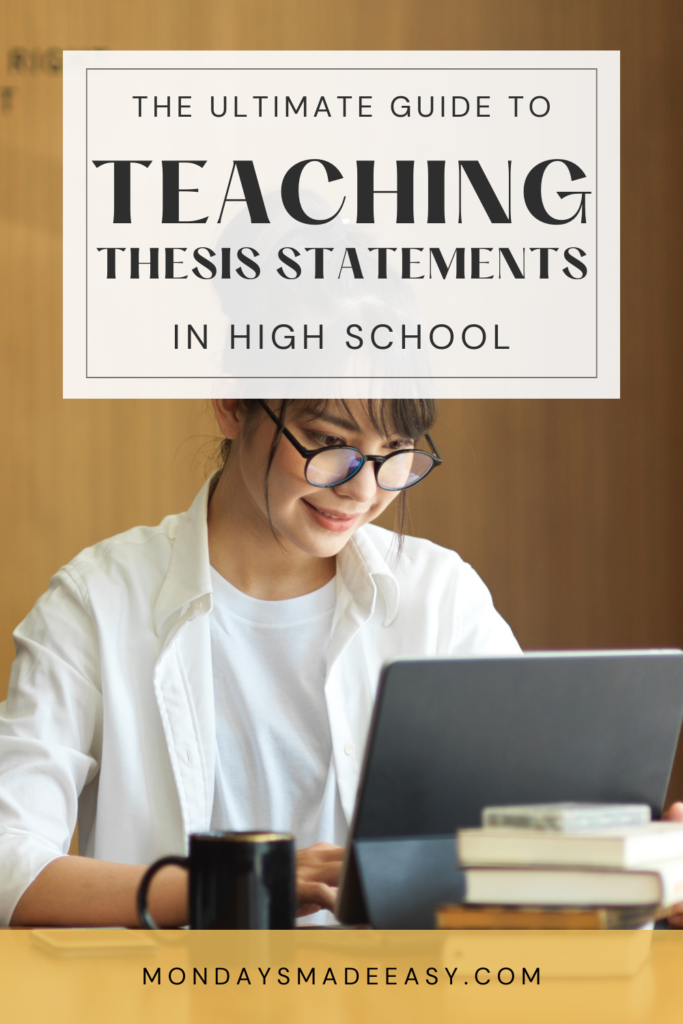
1. Differentiate Between Strong and Weak Thesis Statements
Writing a thesis statement might be a new skill for your students. Thesis statements are often taught as a topic sentence or the “whole essay boiled down into one sentence.” This can be a challenging concept for your students to grasp.
To teach how to write a thesis statement, have a discussion about what makes a strong thesis statement. You can turn this into a collaborative lesson by brainstorming clarifying statements ; these statements dictate what a thesis is and is not.
For example: “ A proper thesis statement is written in one sentence ,” or “ a proper thesis statement is directly related to the rest of the essay .” This is a great opportunity to teach students the difference between concepts like a “topic sentence” or a “hook.”
Your students can use this free bookmark to differentiate between a strong thesis statement and a weak one. This slideshow lesson also explores clarifying statements with detailed examples.

2. Evaluate Thesis Statement Examples
Now that students have plenty of guidelines, challenge their understanding by evaluating thesis statement examples . You can use thesis statement examples from past students’ essays. You can even write your own examples based on the clarifying statements you create with your class.
If you’re open to your students receiving constructive, anonymous criticism , you can even have them write a thesis statement and evaluate each one as a class. I’ve had success with providing students with a thesis statement topic and having them write a thesis statement. Then, I prompt them to swap with their elbow partner to offer feedback.
If you’d rather provide a comprehensive list of thesis statements that reflect the common errors you would typically see in students’ essays, there are several student examples in this introductory lesson on how to write a thesis statement – this is one of my favourite activities for teaching thesis statement writing!
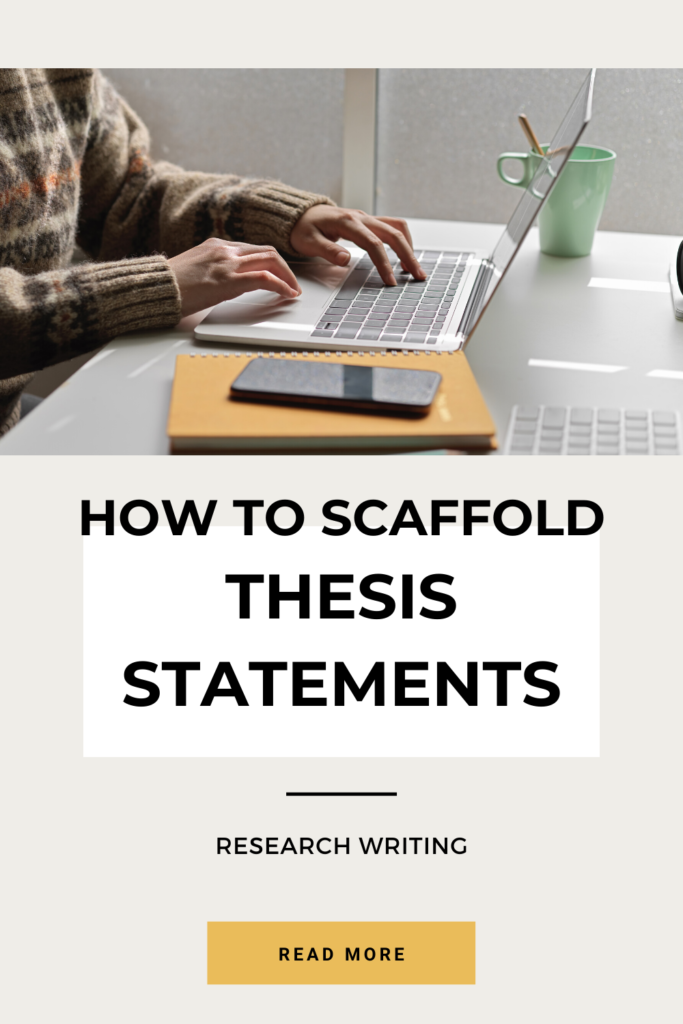
3. Provide a Thesis Statement Template
One of the easiest ways to teach how to write a thesis statement is to offer a thesis statement template . There are a variety of thesis statement templates that students can use as a framework for their essays. I start with a basic template that involves the three parts of a thesis statement: a topic, position, and evidence . I then demonstrate to students how they can create variations of this template, depending on which order they introduce each part. You can find examples for each template in these thesis statement handouts .
You can also introduce a few sentence styles to your students. These styles scaffold eloquent thesis statements. They also offer students the space to articulate their thoughts without exceeding the one-sentence limit.
Sentence Styles for the Three Parts of a Thesis Statement
Here are a few sentence styles that incorporate the three parts of a thesis statement. Each style also includes an example written by a real student:
- Style A : “Noun phrase; Noun phrase; Noun phrase – Independent Clause” Example: “The promotion of hygiene; the presence of medical professionals; the prevention of death – these are all reasons why supervised injection services are an important facet of public health.”
- Style B : If (subject + verb + object phrase), if (subject + verb + object phrase ), if (subject + verb + object phrase ), then (independent clause) Example: “If taxpayers do not wish to have their money allocated to cruelty, if more than 100 million animals die from animal testing a year, if alternatives to animal testing exist, then governments should ban the practice of testing on animals.”
- Style C : Independent clause: subject + verb, subject + verb, subject + verb Example: “College education should be entirely funded by the government: student debt would be eliminated, education would not be commodified, and access to education would not be exclusive to privileged people.”
All of these sentence styles are outlined in these practice worksheets for how to write a thesis statement, with writing prompts to reinforce each thesis statement template through repeated practice.
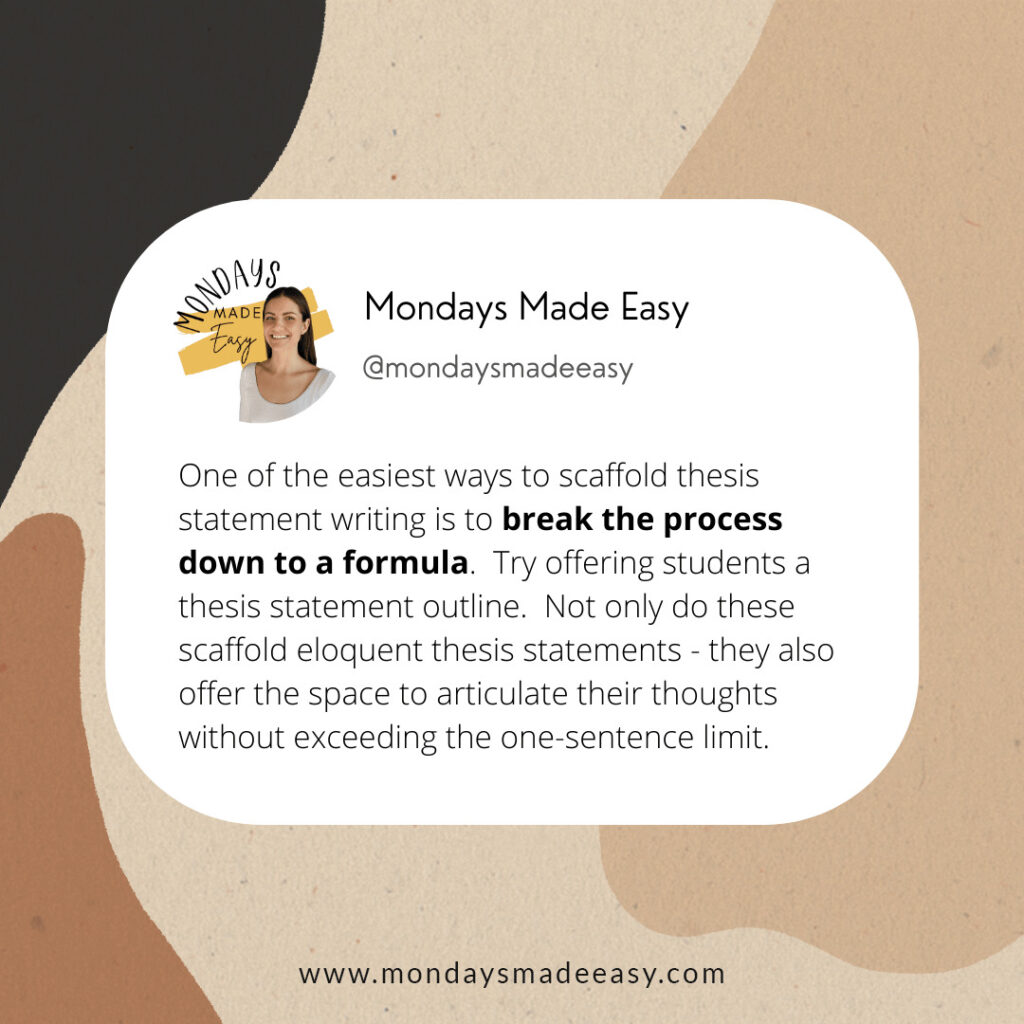
4. Daily Practice Activities to Teach How to Write a Thesis Statement
One of the most effective ways to teach how to write a thesis statement is through repeated practice. You can do this by incorporating daily bell ringers into your persuasive writing unit. To assign this activity, I provide students with three topics to choose from. I then prompt them to develop an opinion and write a thesis statement for one.
I’ll also include bell ringers that provide a thesis statement that students need to evaluate. Students really enjoy these drills! They get the opportunity to develop opinions on interesting topics, and many of them choose to explore these ideas as the subject of their final research paper.
If you’re looking for pre-made worksheets with thesis statement activities, these daily thesis statement bell ringers include one month’s worth of thesis statement prompts, graphic organizers, and templates in both digital and ready-to-print format.
5. Use a Self-Assessment Thesis Statement Anchor Chart
You can provide students with a thesis statement anchor chart to reference the guidelines and rules they’ve learned. A personalized anchor chart is best – like this free thesis statement bookmark – so that students can have it on hand while they are reading and writing.
You can distribute the anchor chart at the beginning of your research paper unit. Students can refer to it while evaluating thesis statement examples or completing daily practice activities. A thesis statement anchor chart has been a complete game-changer in my classroom, and I’m pleased to learn that many of my students have held on to these after completing my course.
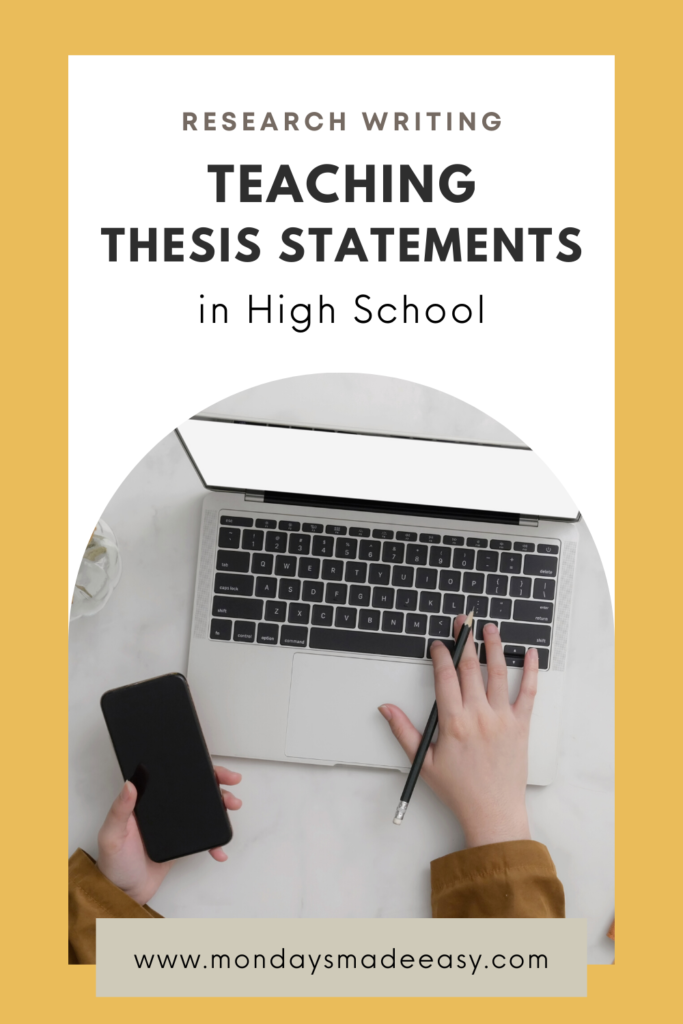
6. Provide Engaging Thesis Statement Topics
You can collaborate with your students to generate an engaging list of good topics for thesis statements. Start by writing down every topic that your students suggest. Then, you can narrow this list down to avoid broad, far-reaching thesis statements that lead to a watered-down essay. When I make this list with my students, we end up with topics that are truly engaging for them. I also have the opportunity to clarify which topics might be a little too vague or broad for an exceptional essay.
For example, students often suggest topics like “racism” or “the problem with school.” These are learning opportunities to demonstrate to students that a great thesis statement is the essential starting point for an even greater essay.
To elaborate, a topic like racism has different implications all over the world. It is far too complex to explore in a single, 750-word essay. Instead, we work together to narrow this topic down to something like “racism in the media,” or even better, “representation in Hollywood.”
Additionally, a topic like “the problem with school” is more of a conclusion. To solve this, we work backward to identify some of the aspects of our school that make it an obstacle . This can include uniforms, early starts, or cell phone policies. This process leads students to a more concise topic, like “cell phone policies in twenty-first-century schools.”
If you’re looking for engaging thesis statement topics to inspire your students, I’ve included a list of 75 argumentative essay topics in this practice unit for how to write a thesis statement .
Tying it All Together
There are plenty of fun thesis statement activities and practice lessons that you can incorporate into your curriculum. Give thesis statements the love and attention they deserve in the classroom – after all, they truly are the most important part of a research essay.
All of the worksheets, lessons, and activities explored in this blog post are included in Mondays Made Easy’s unit for teaching how to write a thesis statement . This bundle has everything you need to teach your students how to master their thesis statements and apply these essential literacy skills to their writing.
It's Lit Teaching
High School English and TPT Seller Resources
- Creative Writing
- Teachers Pay Teachers Tips
- Shop My Teaching Resources!
- Sell on TPT
5 Tips for Teaching How to Write A Thesis Statement

The first time I had students write a thesis, I assumed they knew how to do it. After all, I learned all about the five-paragraph essay myself in middle school in the same school district. To my disappointment, not a single student knew how to write an adequate thesis statement. I realized it was a skill I was going to have to teach myself. After several papers and many years, here are my tips for teaching how to write a thesis statement.

Tips for Teaching How to Write a Thesis Statement #1: Teach Directly
You need a whole lesson around the thesis statement.

It can be ten minutes or a whole class period with note-taking and an activity.
But you have to spend some time directly teaching the thesis statement. You can’t expect students–even seniors in high school–to know what a thesis statement is, its purpose, or where it’s supposed to go.
If you’re teaching an essay writing unit, go ahead and explain the whole essay structure. But make sure you plan some time to specifically touch on the thesis statement and its role.
Don’t have a thesis-specific lesson? Check out my five-paragraph essay mini-lessons here , which include some thesis-specific slides.
Tips for Teaching How to Write a Thesis Statement #2: Explain The Role of a Thesis
I think it’s easy for students to grasp the concept of a thesis. It states what the essay is going to be about. They can get that.
But I think it’s much harder for students to understand how the thesis also guides and outlines the rest of the essay.

By the time they’re writing the conclusion statements for their body paragraphs, they’ve forgotten their own thesis and rarely reference it. Instead of letting their thesis dictate the topic of their body paragraphs, they get stuck trying to come up with something new.
Don’t just tell students what a thesis is. Spend some time showing them how the thesis continues to be referenced in every following paragraph. Show them how the ideas presented in their thesis statement will guide the following paragraphs.
Not sure how? This Unscramble the 5-Paragraph Essay Activity is a great start . Students will have to put the sentences in an essay in order, which can lead to some great discussions about how a strong thesis statement adds clarity to the rest of the essay’s structure.

Tips for Teaching How to Write a Thesis Statement #3: Give Students A Framework
If your students are struggling with writing strong thesis statements, give them a framework.
I know as teachers, it can get really boring to read “W is true because X, Y, Z.” But the structure does work, and it’s a great place for struggling writers to start.
If you’ve used other writing frameworks in class (such as claim, evidence, and reasoning or C-E-R ), your students will be familiar with having a structure for their writing. They’ll be familiar with the concept already and a lot more confident producing their own thesis statements.

Engage your students in more creative writing!
Sign up and get five FREE Creative Writing journal prompts to use with your students!
Opt in to receive news and updates.
Keep an eye on your inbox for your FREE journal prompts!
Tips for Teaching How to Write a Thesis Statement #4: Provide Lots of Examples
As with teaching all new skills, you can never have enough examples.

If your students are writing essays, provide them with examples for the topic they’re covering. But also provide lots of examples for other essay topics.
Give them examples that are both strong and weak, and let them discuss why each is which.
Let them peer-edit one another’s thesis statements.
You can do this in a note-taking style lesson, sit and get discussions, or, my personal favorite, a gallery walk.
If this last idea is interesting to you, check out my Writing Strong Thesis Statements Activity . You’ll place examples of both strong and weak thesis statements around the room. Then, students will have to walk around the room, identifying which statements are strong and which are weak. It’s a great jumping off point for deeper discussions around effective theses.
Tips for Teaching How to Write a Thesis Statement #5: Give Sentence Starters for More Scaffolding
If your students are still struggling, give them sentence starters.
Provide students with the thesis statement itself. Leave a blank for their overall argument and their three supporting reasons (if that’s the structure you expect from them).
Even if your students do alright with writing thesis statements, it might be nice to offer a variety of sentence starters to encourage them to try a new structure for their thesis.

Bonus Tip: Teach the Plural Form
This is a little silly, but I thought I would add it. Teach students that the plural of “thesis” is “theses.”
Every time I use the word “theses” in my classroom, students are tickled by it. I’m not sure why they find the plural version so odd, but it’s an interesting tidbit you can casually share with your students during one of your essay-writing lessons.

Like all good teaching, taking it slow and offering multiple forms of scaffolding is the key to teaching how to write a thesis statement.
If you’re looking for thesis or general essay-writing resources, check out my 5-Paragraph Essay Writing Resources Bundle!

Jump to navigation
- Inside Writing
- Teacher's Guides
- Student Models
- Writing Topics
- Minilessons
- Shopping Cart
- Inside Grammar
- Grammar Adventures
- CCSS Correlations
- Infographics
Get a free Grammar Adventure! Choose a single Adventure and add coupon code ADVENTURE during checkout. (All-Adventure licenses aren’t included.)
Sign up or login to use the bookmarking feature.
Forming a Thesis Statement
Minilesson print.

The whole purpose of writing is to transfer an idea from your head into someone else's. If you can state your idea in a single, clear sentence, your reader can easily grasp it.
Use this simple formula to craft an effective thesis statement (for an essay) or topic sentence (for a paragraph).
Topic (who or what am I writing about? )
+ Focus (what specific thought or feeling do I have about my topic?)
_________________________________
= Thesis Statement (or Topic Sentence)
Here are some examples of the formula in action with different forms of writing.
Explanatory
Antibiotic resistance (topic) creates superbugs through the misuse of modern medicine (focus).
Sex and gender (topic) are related but different, one defined by biology and the other by culture (focus).
Narrative Writing
My hectic senior year of high school (topic) embodied the word overcommitment (focus) .
Your Turn Use the formula to create thesis statements for the following topics. Note: The focus is up to you.
- Career opportunities
- Community involvement
- Generational differences
- The search for colleges
- Lasting lessons of high school

From 30 in Write for College
Teacher Support:
Click to find out more about this resource.
Answers will vary.
Standards Correlations:
The State Standards provide a way to evaluate your students' performance.
- 110.38.c.10.C
- 110.39.c.10.C
- 110.38.c.5.J
- 110.39.c.5.J
- LAFS.1112.W.1.1
- LA 12.2.1.b
- LA 12.2.2.a
- LAFS.1112.W.1.2
- 110.38.c.10.A
- 110.39.c.10.A
- LAFS.1112.W.1.3
© 2024 Thoughtful Learning. Copying is permitted.
k12.thoughtfullearning.com
Related Resources
All resources.
- Seeing Emotion in Facial Expressions
- Seeing Emotions in Body Language
- Calming Down with Deep Pressure
- Teaching the Whole Child (in a Fragmented World)
- Developing Social-Emotional Skills Through Literature
- Inquire Online Middle School Classroom Set
- Inquire Online Middle School Teacher's Guide
- The Science Writer
- The Social Studies Writer
- The Math Writer
- All Write SkillsBook
- All Write SkillsBook Teacher's Edition

Top 3 Product Matches

Adventures of Tom Sawyer
Retail Price: $9.95 Our Price: $7.46 or less

Reproducible
Our Price: $19.95

Downloadable PDF File
Our Price: $14.95
Free Lesson Plans For Teachers
Sign up to get the latest posters, lesson plans, eBooks, puzzles, How to Teach guides, and webinars - for free!
- Crossword Puzzles
- Lesson Plans
- How to Teach Guides
- Other Resources
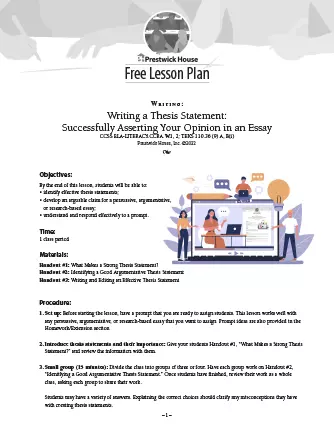
Writing a Thesis Statement Free Lesson Plan
Here is a guided writing workshop to teach students how to brainstorm and draft a thesis statement. This activity provides students an opportunity to consider their prompt and develop a claim that is effective and arguable. Three handouts are included in each download, with the teacher version also containing instructions on how to conduct the workshop.
This lesson plan can be used with any persuasive, argumentative, or research-based essay.
Newsletter Signup
Information and Products
- Privacy Policy
- Terms of Service
- Popular Searches
- Payment Information
- Grammar & Writing
- More Resources
- Order By Catalog Code
Customer Service
1.800.932.4593
Connect With Us
Copyright 2024 Prestwick House. All Rights Reserved.
Reading Worksheets, Spelling, Grammar, Comprehension, Lesson Plans
How to Write a Thesis Statement
About this worksheet:.
Practice developing thesis statements with this writing introduction worksheet! Students will learn how to improve their writing with a strong, attention grabbing thesis statement. This activity helps build writing skills by asking students to create a statement for the topics provided, such as: “What was the greatest challenge in your life?”.
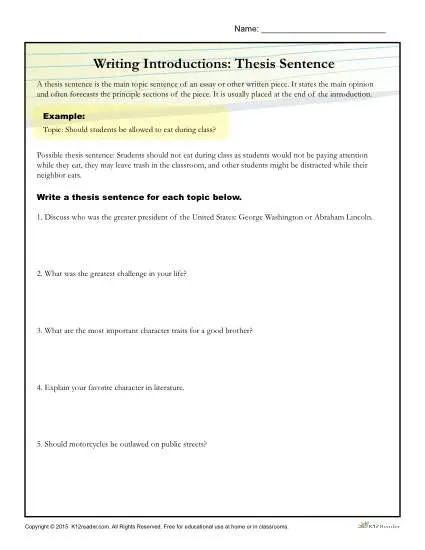
- U.S. Locations
- UMGC Europe
- Learn Online
- Find Answers
- 855-655-8682
- Current Students
Online Guide to Writing and Research
The writing process, explore more of umgc.
- Online Guide to Writing
Thesis Statement and Controlling Idea
So what? This is the question you will get asked if your thesis statement, or main idea, is not obvious in your paper. Your thesis statement is the most important part of your writing; without it, your paper doesn’t have a main point or stance. A thesis statement states the purpose and topic of your writing, and the controlling idea indicates the direction and, often, the writing strategy you will adopt.

Generally, your thesis is placed at the end of your introduction and is a concise and simple sentence that combines your topic and your position on the topic. Like a road map, your thesis lets your readers know what to expect from the rest of your paper. Your body paragraphs support it, and your essay lacks direction without it.
It is important to keep in mind that this early in your writing, your thesis statement is really a working thesis that you use to begin thinking about your topic. You may revise this thesis many times before you are finished thinking and ready to write your final draft. Below are some sample thesis statements.
YOUR TOPIC + POSITION ON TOPIC = THESIS STATEMENT
Thesis statement do's and don'ts.
Present an argument, stance, or claim. Can your audience argue with it?
Provide a key to the organization of your paper. Can you construct body paragraphs that support it?
Mirror the assignment prompt. Are you following what is expected of you?
Present the thesis at the end of the introduction.
Answer the question: “so what?”
Present an argument that can be supported by reputable research. Is your argument logical?
Embrace the “how” and “why” elements. It’s a great strategy to present the problem, examine why it’s a problem, and show how it can be fixed.
Include announcement style language like “this paper will discuss” or “this will be shown in this essay.”
Be informative only with no argument or stance, such as, “Some high school seniors decide to take a gap year.”
Include overly broad or generalized statements like, “Kids of this generation are lazy.”
Force the reader to guess what the paper will prove or discuss
Be questions.
Key Takeaways
Your thesis is one statement at the end of your introduction and should be clear, concise, and arguable.
Without a thesis, your paper lacks direction and purpose.
Mailing Address: 3501 University Blvd. East, Adelphi, MD 20783 This work is licensed under a Creative Commons Attribution-NonCommercial-ShareAlike 4.0 International License . © 2022 UMGC. All links to external sites were verified at the time of publication. UMGC is not responsible for the validity or integrity of information located at external sites.
Table of Contents: Online Guide to Writing
Chapter 1: College Writing
How Does College Writing Differ from Workplace Writing?
What Is College Writing?
Why So Much Emphasis on Writing?
Chapter 2: The Writing Process
Doing Exploratory Research
Getting from Notes to Your Draft
Introduction
Prewriting - Techniques to Get Started - Mining Your Intuition
Prewriting: Targeting Your Audience
Prewriting: Techniques to Get Started
Prewriting: Understanding Your Assignment
Rewriting: Being Your Own Critic
Rewriting: Creating a Revision Strategy
Rewriting: Getting Feedback
Rewriting: The Final Draft
Techniques to Get Started - Outlining
Techniques to Get Started - Using Systematic Techniques
Writing: Getting from Notes to Your Draft - Freewriting
Writing: Getting from Notes to Your Draft - Summarizing Your Ideas
Writing: Outlining What You Will Write
Chapter 3: Thinking Strategies
A Word About Style, Voice, and Tone
A Word About Style, Voice, and Tone: Style Through Vocabulary and Diction
Critical Strategies and Writing
Critical Strategies and Writing: Analysis
Critical Strategies and Writing: Evaluation
Critical Strategies and Writing: Persuasion
Critical Strategies and Writing: Synthesis
Developing a Paper Using Strategies
Kinds of Assignments You Will Write
Patterns for Presenting Information
Patterns for Presenting Information: Critiques
Patterns for Presenting Information: Discussing Raw Data
Patterns for Presenting Information: General-to-Specific Pattern
Patterns for Presenting Information: Problem-Cause-Solution Pattern
Patterns for Presenting Information: Specific-to-General Pattern
Patterns for Presenting Information: Summaries and Abstracts
Supporting with Research and Examples
Writing Essay Examinations
Writing Essay Examinations: Make Your Answer Relevant and Complete
Writing Essay Examinations: Organize Thinking Before Writing
Writing Essay Examinations: Read and Understand the Question
Chapter 4: The Research Process
Planning and Writing a Research Paper
Planning and Writing a Research Paper: Ask a Research Question
Planning and Writing a Research Paper: Cite Sources
Planning and Writing a Research Paper: Collect Evidence
Planning and Writing a Research Paper: Decide Your Point of View, or Role, for Your Research
Planning and Writing a Research Paper: Draw Conclusions
Planning and Writing a Research Paper: Find a Topic and Get an Overview
Planning and Writing a Research Paper: Manage Your Resources
Planning and Writing a Research Paper: Outline
Planning and Writing a Research Paper: Survey the Literature
Planning and Writing a Research Paper: Work Your Sources into Your Research Writing
Research Resources: Where Are Research Resources Found? - Human Resources
Research Resources: What Are Research Resources?
Research Resources: Where Are Research Resources Found?
Research Resources: Where Are Research Resources Found? - Electronic Resources
Research Resources: Where Are Research Resources Found? - Print Resources
Structuring the Research Paper: Formal Research Structure
Structuring the Research Paper: Informal Research Structure
The Nature of Research
The Research Assignment: How Should Research Sources Be Evaluated?
The Research Assignment: When Is Research Needed?
The Research Assignment: Why Perform Research?
Chapter 5: Academic Integrity
Academic Integrity
Giving Credit to Sources
Giving Credit to Sources: Copyright Laws
Giving Credit to Sources: Documentation
Giving Credit to Sources: Style Guides
Integrating Sources
Practicing Academic Integrity
Practicing Academic Integrity: Keeping Accurate Records
Practicing Academic Integrity: Managing Source Material
Practicing Academic Integrity: Managing Source Material - Paraphrasing Your Source
Practicing Academic Integrity: Managing Source Material - Quoting Your Source
Practicing Academic Integrity: Managing Source Material - Summarizing Your Sources
Types of Documentation
Types of Documentation: Bibliographies and Source Lists
Types of Documentation: Citing World Wide Web Sources
Types of Documentation: In-Text or Parenthetical Citations
Types of Documentation: In-Text or Parenthetical Citations - APA Style
Types of Documentation: In-Text or Parenthetical Citations - CSE/CBE Style
Types of Documentation: In-Text or Parenthetical Citations - Chicago Style
Types of Documentation: In-Text or Parenthetical Citations - MLA Style
Types of Documentation: Note Citations
Chapter 6: Using Library Resources
Finding Library Resources
Chapter 7: Assessing Your Writing
How Is Writing Graded?
How Is Writing Graded?: A General Assessment Tool
The Draft Stage
The Draft Stage: The First Draft
The Draft Stage: The Revision Process and the Final Draft
The Draft Stage: Using Feedback
The Research Stage
Using Assessment to Improve Your Writing
Chapter 8: Other Frequently Assigned Papers
Reviews and Reaction Papers: Article and Book Reviews
Reviews and Reaction Papers: Reaction Papers
Writing Arguments
Writing Arguments: Adapting the Argument Structure
Writing Arguments: Purposes of Argument
Writing Arguments: References to Consult for Writing Arguments
Writing Arguments: Steps to Writing an Argument - Anticipate Active Opposition
Writing Arguments: Steps to Writing an Argument - Determine Your Organization
Writing Arguments: Steps to Writing an Argument - Develop Your Argument
Writing Arguments: Steps to Writing an Argument - Introduce Your Argument
Writing Arguments: Steps to Writing an Argument - State Your Thesis or Proposition
Writing Arguments: Steps to Writing an Argument - Write Your Conclusion
Writing Arguments: Types of Argument
Appendix A: Books to Help Improve Your Writing
Dictionaries
General Style Manuals
Researching on the Internet
Special Style Manuals
Writing Handbooks
Appendix B: Collaborative Writing and Peer Reviewing
Collaborative Writing: Assignments to Accompany the Group Project
Collaborative Writing: Informal Progress Report
Collaborative Writing: Issues to Resolve
Collaborative Writing: Methodology
Collaborative Writing: Peer Evaluation
Collaborative Writing: Tasks of Collaborative Writing Group Members
Collaborative Writing: Writing Plan
General Introduction
Peer Reviewing
Appendix C: Developing an Improvement Plan
Working with Your Instructor’s Comments and Grades
Appendix D: Writing Plan and Project Schedule
Devising a Writing Project Plan and Schedule
Reviewing Your Plan with Others
By using our website you agree to our use of cookies. Learn more about how we use cookies by reading our Privacy Policy .
New Product! Create Academic and Professional Success with “Academic Vocabulary”!

Why Thesis Statements Are Important for Kids
Should you teach thesis statements? If so, in what grade should you teach thesis statements? Hey, are thesis statements even important?
Most people don’t really understand what a thesis statement is, and even the people who do understand what a thesis statement is don’t really understand why it is important. Until a few years ago, I didn’t really get them. I didn’t think they were important. I always thought a thesis statement was just a word that English majors liked to use.
When getting my teaching credential I did get straight A’s, and I can honestly say that I never once thought about the term thesis statement . When getting my undergraduate degree, getting good grades was just one of my many interests, so I am quite sure that I cared even less about thesis statements back then. Don’t worry—I did just fine. So, how important are thesis statements if all of this is possible? Do thesis statements really help create good writing? Are thesis statements really an essential element of good writing?
Do We Really Need to Teach Thesis Statements in Elementary School and Middle School?
The California State Writing Standards for 5th grade states this:
Grade 5 Writing Strategies 1.0 – Students write clear, coherent, and focused essays.
Technically, and by definition, an essay has a thesis statement. Okay, so thesis statements may be important. However, when elementary and middle school students are struggling with paragraphs and grammar, thesis statements can SEEM quite unimportant.
In fact, when one considers Piaget’s constructivist learning theory , thesis statements can seem like a waste of time for students who still struggle with a variety of simple writing concepts. Do you want to spend valuable class time teaching students concepts that may not help them just yet? And surely you don’t want students to become so overwhelmed with writing that they think, “Okay, I admit it—I don’t understand writing… and I never will.” Thesis statements can have that effect. So should you or shouldn’t you teach them?
THESIS THINKING: The Real Reason Thesis Statements are Important
What I have now come to see is that you can use thesis statements as a tool for achieving many different writing and reading comprehension results.
Thesis statements have become a coat rack on which I hang many concepts. I’ve come to the conclusion that the most important thing about thesis statements is the THESIS THINKING that goes along with them.
John Truby, a screenwriting teacher, had this to say about story premises. The way he uses the term premise is what I have learned to teach my students about thesis statements.
The very first step in creating a good script is to figure out a great premise. Your premise is your story stated in a single line. It’s probably the most important element in any script, because if it’s not a good premise, there is very little that you can do to make the overall script work—make the overall script something that people will want to read. So it’s very important that you start with a good core idea. –– John Truby –– Screenwriting Teacher
Thesis is very closely related to premise. Let’s substitute thesis for premise and essay for script and see how it reads.
The very first step in creating a good essay is to figure out a great thesis. Your thesis is your essay stated in a single line. It’s probably the most important element in any essay, because if it’s not a good thesis, there is very little that you can do to make the overall essay work—make the overall essay something that people will want to read. So it’s very important that you start with a good core idea.
Put simply, THESIS THINKING is important in all kinds of writing. THESIS THINKING also helps with reading comprehension. In fact, thesis statements and THESIS THINKING help students in all these areas:
• Write powerful topic sentences that put forth important main ideas. • Find main ideas in text. • Write whole compositions with a purpose. • Master the different modes of writing. • Summarize a text. • Narrow or broaden a topic. • Develop clear and concise thinking and clear and concise writing. • Understand the purpose behind each of the different types of essays. • Write and read stories that contain a larger meaning and that communicate a larger message—i.e., stories that have a premise. • And many more!
Back to Piaget—Do Students Really Need to Understand Thesis Statements?
Beginning writers and struggling writers do need to understand thesis statements. However, they are not going to really understand them until they master a variety of foundational skills—skills that will make the concept of thesis statements have real meaning. Piaget certainly would not approve of demanding that students include thesis statements when students don’t understand the following basic concepts and when students don’t possess the following foundational writing skills:
Writing Foundation A: Students must understand and internalize two levels of beginning, middle, and ending:
1. Beginning, middle, and ending in paragraphs. 2. Beginning, middle, and ending in whole compositions.
Writing Foundation B: Students must be able to write basic whole compositions (essays, reports, narratives etc.) quickly and easily. They must own a method for breaking down writing topics and writing prompts and for organizing their thoughts. They must have a method for getting to work and finishing their work.
Writing Foundation C: Students must be in complete control over the paragraph and how paragraphs connect together within an essay. Students must also to be in complete control over the relationship that paragraphs have with the introduction and conclusion.
Parts to Whole: Create a True Foundation for Thesis Statements
As discussed before, thesis statements are, in one sense, the entire essay stated in a single sentence. The thesis statement represents the whole .
Unfortunately, students are taught parts—parts, parts, parts. Students learn that they must be able to write just one good sentence—then just one good paragraph. Then all of a sudden, completely out of the blue, some teacher jumps to the top-down approach. This teacher starts with the whole—i.e., thesis statements.
Students learn parts—and then students learn wholes. But they never have the entire process constructed for them in a way that makes sense. Pattern Based Writing: Quick & Easy Essay is the foundation that makes sense. You will create Writing Foundation A, B, and C, all of them, quickly and easily.
One homeschooling parent had this to say when she found the Pattern Based Writing: Quick & Easy Essay program:
A kind lady on this board put me on the trail of a writing program that I downloaded last night and I think it is revolutionary – I finally ‘get’ it.
A 7th grade teacher had this to say:
I was describing it to a colleague a little while ago as, ‘the basics made clearer.’ I have taught many of these ideas but not as an organized structure. I had no formal way of getting the ideas to be part of my students’ natural writing process. Thank you for this opportunity to enjoy teaching my students writing.
Pattern Based Writing: Quick & Easy Essay is the only writing program I know of that is truly constructivist parts-to-whole essay teaching. That’s why it works! That’s why it makes sense to students, parents, and teachers! If you teach elementary school, or if you have a few struggling middle school writers, be sure to take a serious look at the program on the homepage!
Over 15 Years of Creating Writing Success for Beginning and Struggling Writers of All Ages!
The fastest, most effective way to teach students clear and organized multi-paragraph writing… guaranteed, create academic and professional success today by improving your critical thinking, logical arguments, and effective communication.


IMAGES
VIDEO
COMMENTS
Tips for Writing a Thesis Statement for Middle School Students. Start Simple: Especially for younger middle school students, starting with a simple and straightforward topic can make the process less intimidating. Use Templates: Offering a template can be beneficial. For instance: " [Topic] is essential because of [Reason 1], [Reason 2], and ...
Call on students to offer answers, and list some of the best on the board. Turn the answers into arguments by combining them with the question to form a single thesis sentence, such as "School would be less boring if group work was maximized in the classroom." Assign a separate topic and instruct students to brainstorm and develop their own ...
Activities to Teach How to Write a Thesis Statement in High School. 1. Differentiate Between Strong and Weak Thesis Statements. Writing a thesis statement might be a new skill for your students. Thesis statements are often taught as a topic sentence or the "whole essay boiled down into one sentence.".
The first time I had students write a thesis, I assumed they knew how to do it. After all, I learned all about the five-paragraph essay myself in middle school in the same school district. To my disappointment, not a single student knew how to write an adequate thesis statement. I realized it was a skill I was going to have to teach myself.
A thesis statement is the main idea of a piece of writing. It's typically one or two sentences that sum up the main points/argument and showcase the reason for writing. In most cases, the thesis ...
Step 2: Write your initial answer. After some initial research, you can formulate a tentative answer to this question. At this stage it can be simple, and it should guide the research process and writing process. The internet has had more of a positive than a negative effect on education.
Forming a Thesis Statement. The whole purpose of writing is to transfer an idea from your head into someone else's. If you can state your idea in a single, clear sentence, your reader can easily grasp it. Use this simple formula to craft an effective thesis statement (for an essay) or topic sentence (for a paragraph).
Thesis Statement Activities for Middle School. Clio has taught education courses at the college level and has a Ph.D. in curriculum and instruction. Learning to write a good thesis statement can ...
To answer the first point, before you can answer the question posed by the prompt, you have to answer how you feel about the question for yourself. In other words, do a little brainstorming to see ...
A strong thesis statement provides your essay with direction and lays the foundation for what you plan to argue and support.
Writing a Thesis Statement Free Lesson Plan. Here is a guided writing workshop to teach students how to brainstorm and draft a thesis statement. This activity provides students an opportunity to consider their prompt and develop a claim that is effective and arguable. Three handouts are included in each download, with the teacher version also ...
By helping students to understand the purpose of a thesis statement, how it is put together and where it belongs in a composition, you can equip them with a skill that will make writing faster and easier. The ability to write an effective thesis statement makes it easier for students to write good papers and develops ...
Exercise Directions: Create a thesis statement based on the following information. Topic 1: Education is important to have. It could enable one to get a better paying job. It makes a person a more interesting individual. It makes a person a more informed citizen. Topic 2: Bowling is a sport for everyone.
1 ml_thesis-statement.doc Thesis Statement Mini-Lesson . Lesson Objective . The purpose of this lesson is to provide students with a working definition of a thesis statement while also helping them acquire techniques that will aid them in constructing their own thesis statements. List of Handouts . 1. "Tips for Constructing a Thesis Statement ...
About this Worksheet: Practice developing thesis statements with this writing introduction worksheet! Students will learn how to improve their writing with a strong, attention grabbing thesis statement. This activity helps build writing skills by asking students to create a statement for the topics provided, such as: "What was the greatest ...
A thesis statement states the purpose and topic of your writing, and the controlling idea indicates the direction and, often, the writing strategy you will adopt. Your thesis is like a road map, guiding your readers so that they know what to expect. Generally, your thesis is placed at the end of your introduction and is a concise and simple ...
The purpose of this research guide is to offer a standard format for the teaching and writing of research papers in courses at the Middle Township schools. The guide outlines the process of research, explains devices for organization of research and sources, gives examples of methods for documenting research sources within the paper, explains ...
What Is a Thesis Statement? A thesis statement, often simply referred to as a thesis, is the guiding statement in an essay. Typically one sentence long in most essays, the thesis is the most ...
Do We Really Need to Teach Thesis Statements in Elementary School and Middle School? The California State Writing Standards for 5th grade states this: Grade 5 Writing Strategies 1.0 - Students write clear, coherent, and focused essays. Technically, and by definition, an essay has a thesis statement. Okay, so thesis statements may be important.
2. Theme in Literature. A theme is the main message a reader can learn about life or human nature from a literary piece. From a story you have read in class, identify a theme that the reader may learn from the story. In a well-organized essay, describe this theme.
The thesis statement provides the focus for the writing that follows and lets the reader know what the essay is going to be about. State the topic Example: Football for middle school boys STEPS IN WRITING A THESIS STATEMENT State the main idea of the topic Football is an important sport for middle school boys to play because it helps use their
Organizing an entire middle school English / Language Arts expository reading and writing unit can be daunting and overwhelming. What to teach each day? ... Time to look at thesis statements, discover various types of irony, writing different types of objective summaries, and practice simple, compound, and complex sentence structures in order ...